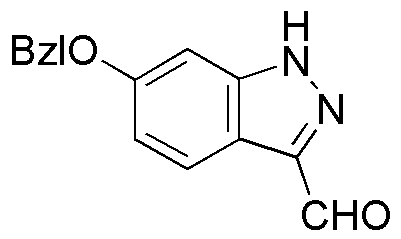6-Benzyloxy-1H-indazole-3-carbaldehyde is widely utilized in research focused on:
- Pharmaceutical Development: This compound serves as a key intermediate in synthesizing various pharmaceuticals, particularly in the development of anti-cancer agents.
- Biological Research: It is used in studies investigating the mechanisms of action of certain drugs, helping researchers understand how compounds interact with biological systems.
- Material Science: The compound can be incorporated into polymer matrices to enhance material properties, such as thermal stability and mechanical strength.
- Organic Synthesis: It acts as a versatile building block in organic chemistry, facilitating the creation of more complex molecules through various reactions.
- Fluorescent Probes: Researchers utilize it in developing fluorescent probes for imaging applications, aiding in the visualization of cellular processes.
General Information
Properties
Safety and Regulations
Applications
6-Benzyloxy-1H-indazole-3-carbaldehyde is widely utilized in research focused on:
- Pharmaceutical Development: This compound serves as a key intermediate in synthesizing various pharmaceuticals, particularly in the development of anti-cancer agents.
- Biological Research: It is used in studies investigating the mechanisms of action of certain drugs, helping researchers understand how compounds interact with biological systems.
- Material Science: The compound can be incorporated into polymer matrices to enhance material properties, such as thermal stability and mechanical strength.
- Organic Synthesis: It acts as a versatile building block in organic chemistry, facilitating the creation of more complex molecules through various reactions.
- Fluorescent Probes: Researchers utilize it in developing fluorescent probes for imaging applications, aiding in the visualization of cellular processes.
Documents
Safety Data Sheets (SDS)
The SDS provides comprehensive safety information on handling, storage, and disposal of the product.
Product Specification (PS)
The PS provides a comprehensive breakdown of the product’s properties, including chemical composition, physical state, purity, and storage requirements. It also details acceptable quality ranges and the product's intended applications.
Certificates of Analysis (COA)
Search for Certificates of Analysis (COA) by entering the products Lot Number. Lot and Batch Numbers can be found on a product’s label following the words ‘Lot’ or ‘Batch’.
*Catalog Number
*Lot Number
Certificates Of Origin (COO)
This COO confirms the country where the product was manufactured, and also details the materials and components used in it and whether it is derived from natural, synthetic, or other specific sources. This certificate may be required for customs, trade, and regulatory compliance.
*Catalog Number
*Lot Number
Safety Data Sheets (SDS)
The SDS provides comprehensive safety information on handling, storage, and disposal of the product.
DownloadProduct Specification (PS)
The PS provides a comprehensive breakdown of the product’s properties, including chemical composition, physical state, purity, and storage requirements. It also details acceptable quality ranges and the product's intended applications.
DownloadCertificates of Analysis (COA)
Search for Certificates of Analysis (COA) by entering the products Lot Number. Lot and Batch Numbers can be found on a product’s label following the words ‘Lot’ or ‘Batch’.
*Catalog Number
*Lot Number
Certificates Of Origin (COO)
This COO confirms the country where the product was manufactured, and also details the materials and components used in it and whether it is derived from natural, synthetic, or other specific sources. This certificate may be required for customs, trade, and regulatory compliance.


